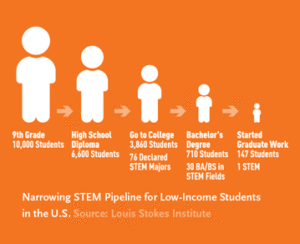Written by The Atlas Team
If, as teachers, we are responsible for fueling the pipeline by preparing more students for STEM careers and education pathways, we need to make STEM accessible for ALL of our students, regardless of sex, race, or socioeconomic background.

STEM and the 4-Dimensional Framework
Dr. Ellington believes that in order to address the issues of diversity and inclusion in STEM, we need an internal transformation. She proposes a 4-dimensional framework to help shift our focus from external strategies to internal changes that encourage us to look at who we are as educators and how we see our work. We can use this framework to cultivate teacher and student mindsets that ensure equitable STEM education. Below are the dimensions, with accompanying internal messaging, that illustrate this new paradigm:
- Student Identity, Agency, Resiliency “I am a competent STEM learner.”
- School Practices & Curriculum “STEM education is critical, vital, and relevant to me, my community, and for solving real problems that matter to me.”
- Teacher Development & Empowerment “Teachers are more than content experts, they are game changers, agents of transformation, and critical partners in transforming lives.”
- Community Social & Cultural Capital “We recognize the historic, cultural, and social contexts of education and draw on the rich community resources to enhance teaching and learning.”
How do we start improving equity?
If the idea of tackling all 4 dimensions seems overwhelming, a crucial place to start is with dimensions 1 and 4 - student and community identity. An individual’s identity is interwoven with their community: you cannot understand one without the other. Our students need to see a place for themselves in STEM. We can help them access this by tailoring our delivery of content to reflect themselves and their community.
1. Student Identity
Our students need to first see themselves as STEM learners, and one major way to do that is to connect what we do in the classroom to their lives. We must consider the context of our students. If we are not familiar with the lived realities of our students, we must make a concerted effort to learn about them. How do they identify themselves? What is important to them?
Learning about our students also helps us shift the narrative of STEM education from employment-centered to living-centered. This is a key point Dr. Ellington emphasizes – too often we try to motivate our students to invest in education with the “you can get a job” argument, whereas we should refocus the argument to “you can live the life you want.” So, instead of asking our students what they want to be or do after school, what if we ask them about the life they hope to live? STEM truly empowers and liberates, so let’s move the conversation from WORKING better to LIVING better.
Consider utilizing self-documentation in your classroom with this STEM teaching tool to put student experiences front and center.
2. Community Partnership
Next, we must partner with our community. No matter where our students are from, their community has something to contribute to our classroom and it’s our job to identify those resources. For example, indigenous communities have unique ways of knowing you can make central during instruction. All communities have their own way of sense-making and fund of knowledge vital to everyday life. The more we focus on these in our classroom, the more likely our students will create their own STEM identity.
Identifying community concerns and issues also helps ground meaningful learning experiences for our students. Is deforestation an issue? Is there a new, invasive species affecting native populations? Start by considering current research projects taking place in your community.
For example, Portland State has a student watershed research project with already-developed related classroom curriculum. If there isn’t a research project your students can participate in, think about incorporating Project, Place, or Problem-Based Learning that allows your students to create their own.
For more ideas, check out 'Teaching STEM In Ways that Respect and Build Upon Indigenous Peoples' Rights' and 'Implementing Meaningful STEM Education with Indigenous Students & Families'.
Before we look to implement classroom strategies to change student outcomes, we need to reorient ourselves as teachers. What do we want for our students? We want students to see themselves as capable and resilient learners not only able to add to the STEM world more broadly, but also to their own communities.
Additional Resources:
- Watch a shortened version of Dr. Ellington’s session from TedX Baltimore.
- Use these briefs to help you think about other aspects of STEM.
- Read this book to for concrete examples of how teachers have adapted STEM to be more inclusive.
Check out our upcoming events that support Equity in Education!
Racial Equity in Education: Beginning the Conversation
 In this monthly group, we will get together to collaborate, learn about, and discuss racial equity and diversity in schools.
In this monthly group, we will get together to collaborate, learn about, and discuss racial equity and diversity in schools.


